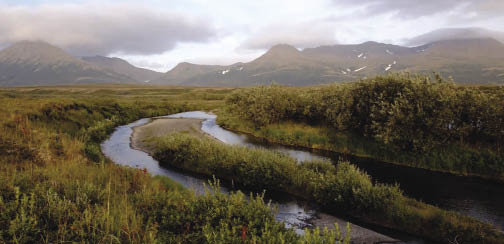
Coldwater sources rely on snow packs in mountainous areas to keep rivers cold throughout the year. Warmer waters are not able to adequately provide a habitat for sustaining many coldwater fish species.
A benefit of more wind energy to the national grid is that it would slow increasing water temperatures, especially in coldwater fisheries, waters for raising and harvesting fish. Trout, salmon, and others depend on clean cold water for survival. Some scientists predict that by 2050, up to 60% of trout populations could vanish, as well as 50 to 90% of their habitat. This also poses a threat for fishermen who depend on the fish in cold water to generate revenue.
“Traditional energy sources have negative affects on freshwaters,” says T.O. Smith, RE Coordinator with Trout Unlimited (tu.org). “Snow packs in mountainous areas are melting quicker and are unable to keep rivers cold throughout the year.” Trout Unlimited focuses on balancing conservation of coldwater fisheries with economic development to help mitigate the impact to fish habitats. Warm water does not hold as much oxygen as cold water so the temperature changes force fish to find new habitats for survival.
Sadly, finding promising water may be impossible with overburdened freshwater resources. Consider that about 40% of freshwater withdrawals are being made by power plants according to a recent National Geographic article. Now, a 24-month study conducted by a Bureau of Reclamations reveals the need to cut water released from Lake Powell’s Glen Canyon Dam by 750,000 acre-feet next year because water in the lake is at an historic low. The dam regulates the severely endangered Colorado River, a flow which has been deemed unsustainable due to the clutter of dams and diversions. A report conducted by the Energy and Water in a Warming World Initiative entitled, “Water-Smart Power: Strengthening the U.S. Electricity System in a Warming World,” suggests that adding more low-carbon energy sources, such as wind energy, could reduce water withdrawal by 97% by 2050.
Smith says wind energy provides one solution to the problem because it uses no water. The cost of wind energy has decreased making it an option, and 35% of all new power capacity installed over the last four years has come from wind. Aging power plants will soon phase out due to the increased demand for clean energy production. “More wind energy helps diversify energy sources and lessens the need for water consumption,” says Smith. “This is a start and a definite reason to keep moving toward renewable energy.” WPE
Filed Under: Featured, News, Policy




